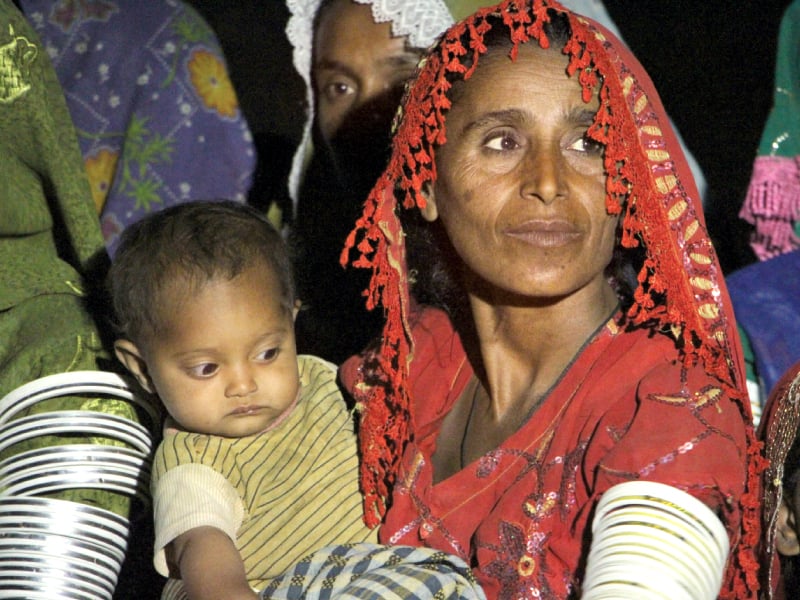
Clad in a ghagra that swirls as she walks, she presents a colourful sight, unlike her often colourless life. Her arms are covered in white bangles worn almost up to her shoulders, a mark that she is married. But the arms of Najma Chandio are much too thin; her skin is shrivelled more than it should be for a 28 year old woman. She shows signs of malnutrition.
Najma gave birth to Ghulam Siddique four days ago. She is currently admitted in a private clinic in Tehsil Chachro, district Tharparkar. “I cannot feed my baby. I cannot produce milk for my infant,” shared Najma, sounding frustrated. She travelled from her village Rawatsar to Chachro, a distance of 80 kilometers, to get to the private clinic for treatment.
Health and Nutrition Development Society (HANDS) have observed a change in breastfeeding trends in Tharparkar. According to a survey conducted by HANDS, there were 39 per cent women breastfeeding their babies before the drought calamity, which has reduced to 28 per cent. “The main reasons are malnourishment, poverty and lack of awareness,” said Dilip Kumar, Acting General Manager of the health department at HANDS. According to him, a lot of the women are unaware of the duration that their children should be breastfed.
Another case in point is Nazeeran, a 29 year old, mother to a four month old baby Shakeel Ahmed in the village Nasrullah Sand of Tharparkar. “It has been three months since I breastfed my son. This is because of less milk. I cannot feed him properly.” The infant has fever every now and then. “He is always cranky and crying because I am unable to feed him properly.”
The data provided by Association for Water Applied Education & Renewable Energy (AWARE) confirms that Thari women are having problems breastfeeding their children. In March 2014, 140 women attended Out Patient Department (OPD) of Chachro’s Taluka Headquarters Hospital. The AWARE team shared that when they spoke to the hospital’s staff, they said there are no supplements or any medicines for lactating mothers. This is why malnourished women are becoming even more malnourished.
Doc talk
When a malnourished woman gives birth, her baby will be underweight, says Dr Moti Khan, senior dietician at Aga Khan University Hospital. “In Pakistan, pregnant women do not follow a prescribed diet plan.” The expert was of the view that non-affordability of edibles and not knowing what kinds of foods are healthy is the reason behind malnutrition.
According to Dr Sadia Ahsan Pal of the National Committee for Maternal & Neonatal Health (NCMNH), a malnourished mother’s poor health will affect the baby’s health when she breastfeeds. Pal said that malnutrition in rural areas is high because of poverty. She added that there is no family planning in villages. “Mothers don’t take a gap of two to three years before getting pregnant again. A mother needs this time to regain her health before she is fit enough to give birth again and breastfeed the baby,” said Pal.
While speaking to The Express Tribune, Pal added that “Getting girls married at a young age is a recipe for disaster. They get pregnant when their bodies are not completely mature and fit. Malnutrition then becomes obvious.”
When asked about the symptoms of malnutrition, Pal was of the view that there are different indications. “Some women will begin to lose weight and will look weak,” she said, adding that some women may apparently be healthy, but have internal deficiencies like those of vitamins, iron, protein etc.
According to Pal, in most families in our society, women eat in the end after they are done feeding other family members. “Women, especially in rural areas, do all the field work, whereas the men sit on chaarpaais and smoke the hukkah. Isn’t this enough to make women grow weaker?”
For Dr Razia Korejo, professor of obstetrics and gynecology at Bahria University Medical and Dental College, a mother cannot breastfeed her baby if she is weak. “If a malnourished mother keeps breastfeeding her baby, her health will deteriorate even more.”
Korejo was of the view that a female will only be able to take care of her health and her child’s if she is educated and aware. “Rural women have no knowledge of anemia. Instead of going to the doctor for advice, they get pregnant.” Korejo said that this leads to complications when the woman goes in labour and the baby is born underweight.
Ground realities
According to the team at AWARE, there are lady workers who are working in Tharparkar, but not enough. For example in village Nasrulla Sand, there are only two lady health workers and they are working for eradication of polio. Nasrullah Sand and Rawatsar villages are near the Indian border. A Rural Health Centre was established in 1979 in Tehsil Chachro; however, there is no lady doctor or pediatrician available.
Published in The Express Tribune, April 8th, 2014.
COMMENTS (1)
Comments are moderated and generally will be posted if they are on-topic and not abusive.
For more information, please see our Comments FAQ



1732263441-0/BeFunky-collage-(81)1732263441-0-165x106.webp)
1732263755-0/musk-(3)1732263755-0-165x106.webp)



1732258132-0/BeFunk_§_]__-(26)1732258132-0.jpg)
1732257537-0/Copy-of-Untitled-(64)1732257537-0-270x192.webp)
1726722687-0/Express-Tribune-Web-(9)1726722687-0-270x192.webp)






Dear mothers, sisters and daughters
eat proudly your Grass because Pakistan has 120 Atom bombs and over one million soldiers to protect you!